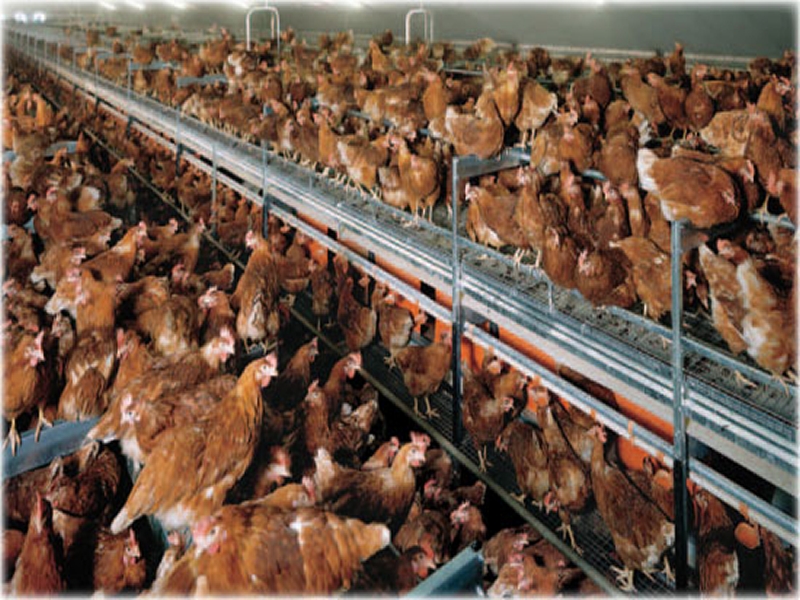
Big Dutchman multi-tiered “cage-free” facility.
Multi-tiered facilities are stacked with tiers crowded with hens.
There is no “unfettered access to vertical space” in these
densely packed facilities.
Farmed Animal Welfare Law Betrayed in Massachusetts
Massachusetts voters in 2016 passed a ballot measure for pigs, calves, and laying hens that would have required 1 1/2 square feet of living space for each hen. Regulations were to become effective this month, and the law was to take effect on January 1, 2022 meaning that by that date, the state’s egg producers were to have complied with the space mandate.
But most likely that is not going to happen. As reported by Food Safety News (FSN) in Face egg shortage or adopt national standard are choices for Massachusetts on Oct. 14, 2021, a proclaimed “shortage” of eggs in the U.S. plus the failure of MA egg producers to comply with the law has led instead to MA Senate Bill 2470. Now in the state legislature and effective Jan. 1, 2022 if passed into law, the bill reduces the space requirement per hen from 1.5 square feet per hen to 1 square foot per hen, thus subverting the will of MA voters and making life more miserable for the hens – a bleak, unfulfilling life even with a foot and a half of living space for each “cage-free” hen.
FSN rightly reports that battery cages for hens, in which 74 percent of 243 million U.S. hens are currently confined, are designed to achieve high density of hens within the battery-caged environment: more hens per unit = more eggs = more money.
What is not made clear is that uncaged, or “cage-free,” operations are designed to achieve the same high-density purpose as battery-cage operations. Instead of crowding hens in cages or on a single huge “cage-free” floor, producers are stuffing many more hens into these “cage-free” buildings by stacking them on platforms placed vertically above the floor as well as on the floor.
FSN suggests that the purpose of these “vertical aviaries” is to allow the hens “to fly upward, perch and roost,” echoing the redesigned legislation which states that “1 square foot of usable floor space per hen . . . provides hens with unfettered access to vertical space.” This “unfettered access” claim, practically speaking, is false.
In practice, if a hen on a platform tries to flutter down to the floor, she can break or dislocate her wings, legs or breast bone in her frustrated effort to land in a space that is free of hens. Chickens do not choose to land on other chickens, and they do not want to hurt themselves by doing so, and will therefore often stay where they are rather than risk injury. These hens face a similar challenge in trying to fly up from one platform to the platform above.
FSN rightly observes that battery cages do not provide enough space for occupants to “fully open wings, let alone to run, or jump.” But neither do these “cage-free multi-tiered” buildings. Consider that one square foot equals 144 square inches and that half a square foot equals 72 inches and that a three-to-four pound hen needs a minimum of 74 square inches merely to stand, 197 square inches to flap her wings, 135 square inches to ruffle her feathers, 172 square inches to preen her feathers, and 133 square inches to scratch the ground, as noted in the May 1990 Poultry Digest.
In addition it must be pointed out that a law stating that each hen must be able to fully extend her limbs, especially her wings in the conventional “cage-free” setting, does not mean that all hens simultaneously could do that if they wished. It merely means that one hen at a time must be able to spread one or two wings. MA SB 2470 would require only that hens have enough space to stand up, turn around, and lie down. The proposed MA law will be consistent with other states’ cage-free standards, rather than being competitively disadvantaged, says FSN.
What Can I Do?
Be sure to read the comments to Face egg shortage or adopt national standard are choices for Massachusetts in Food Safety News, posted below the article by Gail Eisnitz of the Humane Farming Association, Mary Finelli of Fish Feel, and Yours Truly, Karen Davis, of United Poultry Concerns (“Chicken Advocate”).
If you are a Massachusetts voter, please tell your state legislators that you want the original 2016 law to remain in effect unchanged. Request a written reply.
For more information on “cage-free” standards, see:
California Ballot Initiative to “Prevent Cruelty”